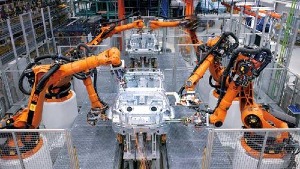
Machines replacing people in the workplace is a rising controversy in the United States. For some, it is a solution to a shortage of workers. To others, it is a precursor for many jobs being eliminated.
Corey De Buhr inherited his family’s 245-acre dairy farm in Lancaster, Wisconsin in 1994. However, as is the case with many other farm families, the rest of De Buhr’s family is not interested in working on the farm. As more advanced and intellectually demanding jobs continue to flood the job market, the number of people working on farms is decreasing. While De Buhr does have part-time and full-time employees, finding enough workers is difficult.
“There has been some decline in available immigrant labor and young workers too often spend time fixated on their phones,” said De Buhr.
Many workers have been demanding higher wages for working on farms. In De Buhr’s case, he had to raise the hourly rate from $8 to $10, and $14 more recently, to meet the demands of his workers. Due to the rising wages he had to pay, De Buhr made a decision that more and more farmers across the country are making. He chose to replace the need for some manual labor by investing in a $200,000 robotic milker. Although these robotic milkers, produced by German company GEA Farm Technologies, have been in existence for nearly 20 years, they have been gaining more popularity recently. Many farmers have experienced the same shortage of workers as De Buhr, and have resorted to machines instead of unreliable workers.
“[The machine is] milking 24/7 and I don’t have to worry about somebody not showing up,” claimed De Buhr. “You can mess a herd of cows up in a big hurry if they’re not milked in a timely manner.”
De Buhr’s view on mechanization in the workplace is positive, as is the case with many others nationwide. Due to the growing worker shortage, replacing manual labor with machines and robots has become crucial for many farms and factories. Wisconsin, for example, has 2.5 robots for every thousand workers, a number which has increased by 124 percent between 2010 and 2015.
“There is forced automation because of forced challenges with workforce,” said Steve Jahn, executive director of an economic development group in Wisconsin.
Critics, however, claim that the mechanization within companies is taking jobs away from people who need them. While implementing robots in the workplace creates new, higher-paying jobs for engineers, programmers, and technicians, it also eliminates jobs that require less education. There are many people without a higher education, who could not be employed as an engineer or a technician, but who could do manual labor, such as milking cows and general work around a farm. Also, the 25 million jobs that are expected to disappear in the next 10 years will likely be replaced by only 15 million new jobs, according to a study conducted by a research company focusing on technology in the workplace.
Nevertheless, supporters of machine implementation state that decreasing the number of jobs that require less education is not a problem. A key reason that companies adopt new machinery is because there are not enough people willing to do the work in the first place. Researchers like Rob Radwin, a professor of industrial and systems engineering at UW-Madison, expect that robots and machinery will play an important role in companies in the future. People will be in charge of work in which interaction, complicated thinking, and adaptation are involved, leaving robots to do the rudimentary, repetitive jobs.
The controversy over whether mechanization in the workplace is helping or hurting our economy and people continues. Regardless, the development and implementation of technology is transforming our world, and having robots take over jobs previously completed by humans may be another step towards creating a machine-run society.
[Source:
The Wisconsin State Journal
]

